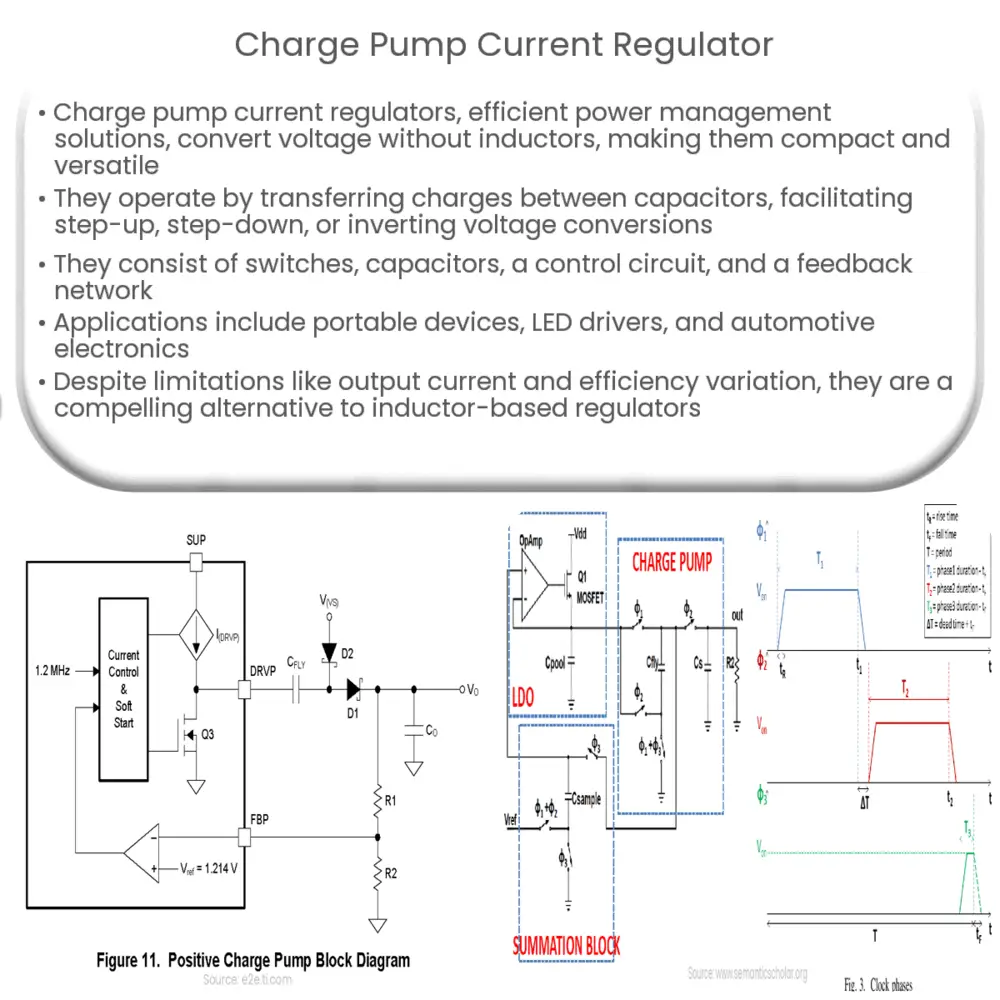A charge pump current regulator is a compact, efficient voltage converter that manages electrical currents in electronic systems without using inductors.

Charge Pump Current Regulator: An Overview
Introduction
A charge pump current regulator is an innovative power management solution that plays a crucial role in managing electrical currents within an electronic system. It is a switched-mode voltage regulator that enables the conversion of voltage levels without the need for an inductor. This type of regulator has gained prominence in the electronics industry due to its compact size, efficiency, and versatility. In this article, we will explore the working principle, key components, and applications of charge pump current regulators.
Working Principle
Charge pump current regulators operate based on the fundamental principle of converting voltage levels through charge transfer. This conversion process typically involves transferring charges between capacitors, which are the primary energy storage components. The charge pump circuit comprises a network of capacitors and switches that control the flow of electrical charges. By alternating the positions of these switches, the capacitors can either store or transfer charges, effectively regulating the output voltage.
The charge pump circuit can be designed to achieve different voltage conversion modes, such as step-up (boost), step-down (buck), or inverting voltage conversion. In the step-up mode, the output voltage is higher than the input voltage, while in the step-down mode, the output voltage is lower than the input voltage. In the inverting voltage conversion mode, the output voltage is the inverse of the input voltage. The mode of operation depends on the specific application requirements and design of the charge pump circuit.
Key Components
A charge pump current regulator typically consists of the following key components:
- Switches: These are semiconductor devices, such as MOSFETs, that control the flow of electrical charges within the charge pump circuit. They can be either integrated or external, depending on the design of the regulator.
- Capacitors: These energy storage components are responsible for storing and transferring charges during the voltage conversion process. They can be ceramic, tantalum, or electrolytic capacitors, depending on the application requirements and design constraints.
- Control circuit: This component is responsible for managing the timing and control signals for the switches. It ensures that the switches operate in a coordinated manner to achieve the desired voltage conversion.
- Feedback network: This network monitors the output voltage and provides feedback to the control circuit to maintain the desired voltage level. It can be either an analog or digital feedback mechanism, depending on the design requirements and performance objectives.
Applications
Charge pump current regulators have been widely adopted in various electronic applications due to their compact size, efficiency, and versatility. Some of the common applications include:
- Power supply for portable devices, such as smartphones, tablets, and wearables
- LED drivers for backlighting and general illumination
- Bias voltage generation for operational amplifiers and analog-to-digital converters
- Power management in automotive electronics and industrial control systems
Advantages of Charge Pump Current Regulators
Charge pump current regulators offer several advantages over traditional inductor-based voltage regulators, such as:
- Compact size: Charge pumps eliminate the need for bulky inductors, leading to smaller and more compact designs. This is particularly beneficial for space-constrained applications, such as portable devices and wearables.
- Lower cost: The absence of inductors and the use of fewer components in charge pump designs often result in lower overall system costs.
- Lower electromagnetic interference (EMI): Unlike inductor-based regulators, charge pumps produce less EMI due to the absence of inductor switching, which simplifies EMI management and compliance.
- Efficiency: Charge pumps can provide high efficiency for certain applications, especially when the input and output voltage levels are close.
Limitations of Charge Pump Current Regulators
Despite their advantages, charge pump current regulators also have certain limitations:
- Output current limitation: Charge pumps are generally limited in their ability to supply high output currents compared to inductor-based regulators. They are best suited for applications with low to moderate current requirements.
- Efficiency variation: The efficiency of charge pump regulators can vary significantly with the input and output voltage levels, as well as the load conditions. Inductor-based regulators usually offer better efficiency across a wider range of operating conditions.
- Higher output voltage ripple: Charge pumps tend to have higher output voltage ripple compared to inductor-based regulators, which may require additional output filtering for noise-sensitive applications.
Selecting the Right Charge Pump Current Regulator
When choosing a charge pump current regulator for a specific application, several factors must be considered:
- Input and output voltage requirements: Ensure that the chosen charge pump regulator can provide the desired voltage conversion (step-up, step-down, or inverting) based on the input and output voltage requirements of the application.
- Output current requirement: Consider the maximum output current required by the application, and choose a charge pump regulator that can deliver the necessary current while maintaining efficiency and minimizing heat dissipation.
- Size constraints: If the application has strict size constraints, a charge pump regulator with a compact design and minimal external components may be the ideal choice.
- Cost considerations: Evaluate the overall cost of the charge pump regulator, including the cost of external components, and compare it with other power management solutions to make an informed decision.
Conclusion
Charge pump current regulators have emerged as a versatile and compact power management solution for various electronic applications. By understanding their working principles, key components, advantages, and limitations, engineers and designers can make informed decisions when selecting the right charge pump regulator for their specific applications. While charge pumps may not be suitable for all scenarios, they offer a compelling alternative to traditional inductor-based voltage regulators in many situations.

